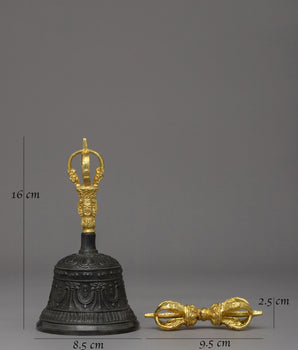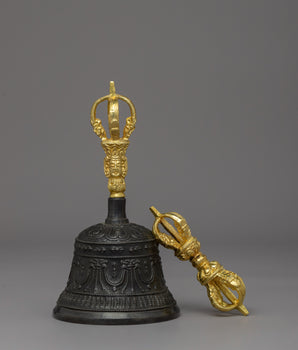The Timeless Harmony of Awakening and Protection
Dharmadhatu and the Vajra in the vast field of Buddhist symbolism, there are a few symbols that stand out for both their beauty and the profound truths they reveal. Of these symbols, Standing on the Vajra and the Dharmadhatu are some of the most effective. Although each symbol offers profound meaning for one's path, together, they can form a sacred symbol that benefits from hundreds of years of philosophical thought, ritual efficacy, and spiritual clarity.
The symbol of the Dharmadhatu signifies the ultimate nature of reality, which is pure, limitless, and free from illusion. It represents the truth of existence, that unconditioned space in which all things arise and dissolve. By contrast, the Vajra is an indestructible force, spiritual will, and the clarity of awakened wisdom. The two symbols present a fundamental perspective in Buddhist thought: the awakening to the truth of our being is not separate from our realization of strength and recognizing it as an agent in protecting and creating peace through awareness.
What Is Dharmadhatu?

The Dharmadhatu is a pivotal concept in Buddhism, often referred to as the "truth domain" or "ultimate reality," and represents a pure, ultimate reality that exists beyond the obscurations of illusion, duality, and conditioned experience. The Dharmadhatu is symbolically illustrated as a circle, or the cosmic wheel, to portray the aspects of infinity, oneness, and interdependence of everything. It is the unobstructed space of the mind, from within which enlightenment can arise, away from the chaos of thinking and shadow consciousness. Some Buddhist traditions draw similarities between the Dharmadhatu and the state attained through Nirvana, a state beyond suffering, ignorance, and ego. Ultimately, the Dharmadhatu is the spiritual matrix of all phenomena, representing an infinite domain of existence characterized by thoughts of truth, clarity, and peace that exist naturally.
What Is The Vajra?

The word "Vajra" comes from Sanskrit and means "diamond" or "thunderbolt." Thus, it indicates aspects of being indestructible and an irresistible, immovable spiritual force. Vajra, unbreakable as a diamond or as quick and powerful as a thunderbolt, embodies the immovable power of the enlightened mind and the dynamism of transformation. The Vajra also represents the union of opposites—wisdom and compassion, both of which are necessary for spiritual awakening. The Vajra illustrates this union of opposites, featuring a sphere at its center with symmetrical prongs on each end that display oppositional relationships of emptiness and stillness. Within a ritual, the Vajra is held in the right hand to represent the method or compassionate action, and the bell in the left hand to symbolize wisdom; together, they exhibit what is known in Buddhism as the inseparability of compassion and insight, which are the steps toward enlightenment.
The Fusion of Peace and Protection

The Dharmadhatu and the Vajra exhibit a harmony found nowhere else in art and rituals, as their relationship embodies spiritual completion and spiritual power. This has important meanings individually; they signify the realization of truth through unwavering clarity and enduring strength.
The Dharmadhatu is the ultimate reality, characterized by complete purity and fullness, without limit and unaltered by illusion; it is the object of focus for all Buddhist practitioners. It is this awareness of our existential condition. The Vajra is the analogy of the indestructible path that leads to realization. It is the understanding, spiritual power, and compassionate action necessary for penetrating illusion and achieving liberation into enlightenment. It signifies the union of both wisdom and method. This principle has been built into Mahayana and Vajrayana. Wisdom without compassionate action is incomplete. At the same time, action void of wisdom may lead to confusion. Thus, in combination, it signifies the completion of balance and the path to awakening. This also serves as a protective shield. It indicates to practitioners that inner peace must be defended by clarity and that true power comes from understanding the nature of reality. This emblem is often incorporated into sacred art, rituals, and spiritual jewelry as a reminder of an enlightened state of being.
Spiritual and Historical Significance
The Dharmadhatu with Vajra is a powerful symbol with substantial spiritual and historical importance for the Buddhist tradition. The symbol represents the integration of the ultimate truth and indestructible wisdom. The Dharmadhatu is a pure existence that is unaffected by illusions and duality, revealing the authentic nature of reality. The Vajra is the inner transformative energy of realization and clarity needed to cut through ignorance and attachment. These symbols call on practitioners to act with compassion, strength, and clarity in the face of life's numerous challenges, enabling them to move deeply along the path of realization.
The Vajra has historically been an important ritual tool in Vajrayana Buddhism. The significance of the vajra goes back to the practices of ancient Indian and Tibetan spiritual traditions. The Dharmadhatu and the importance of this notion in early Mahayana philosophy indicate that reality is infinite. Their integration has historically emerged as a powerful vehicle in Vajrayana, and it also represents the inseparability of wisdom and method, truth and power, in modern cultural life. For centuries, this symbol has been regarded as sacred and reverential, continually appearing in monasteries, holy art, scriptural traditions, and gatherings across the Himalayan region and throughout the world. This led to the symbol continuing its essential mission in promoting the idea of peace, protection, and spiritual awakening.
Dharmadhatu with Vajra in Sacred Sites: Living Symbols in Nepal
1. Swayambhunath Stupa

The Swayambhunath Stupa in Kathmandu is a well-known representation of the Dharmadhatu with a Vajra. Visitors stepping onto the top of the eastern 365-step stair to Swayambhunath see Vajra Dhatu in the shape of a mandala. Surrounding the base are twelve engraved animals signifying the twelve months in the astrological cycle, of which there are birds, bulls, dogs, tigers, horses, rabbits, lightning, monkeys, mice, pigs, snakes, and sheep.
The Vajra is the focal point of Buddhism, signifying spiritual power and protection in its role as a faithful guardian of truth. The organization was initiated in the 17th century by King Pratap Malla, who placed two stone lions next to the Vajra, constructed the eastern staircase, and additional shrines. It now continues a strong tradition as a representation of the actualization of unshakeable wisdom and the ultimate reality.
2. Hiranya Varna Mahavihar (Golden Temple)

(Photo From iStock)
Hiranya Varna Mahavihar, also known as the Golden Temple, is in Patan. This historical Newar monastery features a Vajra, often figuratively placed at the center of the complex, typically resting on a platform modeled after a mandala. While the Dharmadhatu is normally not emphasized by a visible representation, it can still be expressed through the circular arrangements of the temple and its activities, which reveal the indefinable and infinite nature of truth, as well as its professed opportunities for awakening; the villagers may present their pilgrimages with the Vajra, in the temple, representing some degree of an unwavering power, liberty, and the beginning or continuum of the paths of insight or compassion alive within the walls of the Biharas.
3. Yasodhara Mahavihar (Bubahal), Patan

Yasodhara Mahavihar, located in Patan, was built in the 12th century as one of the largest and most prominent monasteries. At the center is a representation of the Dharmadhatu and the Vajra, a circular design symbolizing ultimate truth, layered on top of a metal Vajra that represents indestructible wisdom and protection. The object represents the ritual life of the Newar Buddhist community, which includes prayers and offerings derived from daily life and celebrates the use of spiritual icons through community and culture.
Use of Dharmadhatu With Vajra
The Dharmadhatu with a Vajra can be incorporated into various aspects of Buddhist life as a representation of spiritual truth and power. Specific applications are as follows:
1. In Religious Spiritual:
-
Displayed within Buddhist monasteries and temples.
-
Utilized in Thangkas (sacred paintings), Mandala, and statues.
-
Used as ritual artifacts by monks and lamas in religious practice.
2. In Personal Spiritual Practices:
-
Worn as jewelry or carried as talismans to remind them of protection or mindfulness.
-
It is located on home altars as a reference for spiritual peace and clarity during meditation.
3. In Cultural and Artistic:
-
Used in Buddhist art and architecture to denote temples.
-
Presented as decorative aspects for ceremonial purposes to represent the union of truth and spiritual prowess.
Contemporary Interpretation of Dharmadhatu with Vajra

In this new world of speed and change, the Dharmadhatu with Vajra is still relevant as a representation of balance and stability. A contemporary interpretation for practitioners and seekers today, the Dharmadhatu can serve as a reference point for either distraction as a practice or for distraction becoming a motivation based on truth and clarity. It can be understood as the recognition of reality, a mind free from illusion, just as the Vajra represents the strength of mind, courage, and compassion.
The Vajra Dhatu is a transdisciplinary reference that transcends a unique tradition or religion, particularly for anyone seeking mental clarity, emotional stability, and spiritual protection. While the Dharmadhatu with Vajra may be significant within a traditional Buddhist context, it is also relevant to anyone with an interest in mindfulness, meditation, and holistic well-being. There is something humanly universal about the Vajra Dhatu that feels sincere as we explore our inner peace, wisdom, and the courage to find strength in life's calamities.
Conclusion
The Dharmadhatu with Vajra is a temporal symbol of peace, protection, and deeper understanding. Grounded in Buddhist philosophy, while we encounter the Vajra Dhatu in ancient monasteries, sacred art, or in our practice, its continual reminder is that awakening occurs through the reconciliation of method and wisdom. The Dharmadhatu and Vajra can help us stay centered, clear, and grounded. Helpfully and gratefully, this symbol not only belongs to a religious tradition but also extends universally to all who seek inner peace and clarity, as well as the brave, compassionate courage to face oneself and the challenges that confront us in life. Its sacred symbol remains a guiding light and direction toward our spiritual awakening, reminding us that peace and protection are offered from profound truth and enlightened action.











